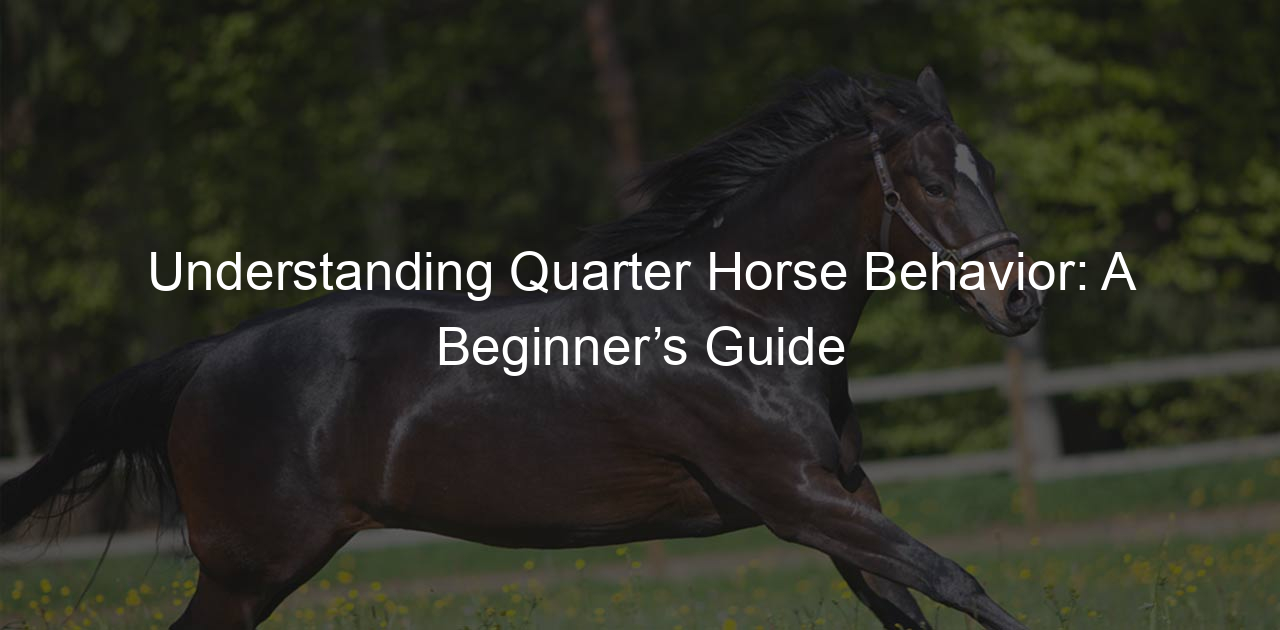
Introduction to Quarter Horse Showmanship
-
Definition of Quarter Horse Showmanship
Quarter Horse Showmanship is a competitive event where handlers showcase their skills in presenting their horses. This involves leading the horse through a series of maneuvers, such as walking, trotting, and pivoting. The goal is to demonstrate the handler’s ability to control and present the horse effectively.
-
Importance of Mastering Quarter Horse Showmanship
Mastering Quarter Horse Showmanship is crucial for several reasons:
-
- Builds a Strong Bond: It helps in building a strong bond between the handler and the horse.
- Enhances Skills: It improves the handler’s skills in horse management and presentation.
- Competitive Edge: It provides a competitive edge in horse shows and competitions.
Understanding Quarter Horse Training
Basic Quarter Horse Training Techniques
- Groundwork TrainingIt helps build trust between the horse and the trainer. This training involves exercises like leading, backing up, and moving in circles. These exercises teach the horse to respond to commands and build good manners.
For example, leading exercises help the horse learn to follow the trainer without pulling. Backing up teaches the horse to move away from pressure. These basic skills are essential for more advanced training later on.
- Saddle TrainingThis involves getting the horse used to wearing a saddle and carrying a rider. At first, the horse may feel uncomfortable with the saddle. Trainers start by placing the saddle on the horse’s back and letting it get used to the weight.
Once the horse is comfortable, the trainer will slowly introduce riding. This includes mounting the horse and teaching it to walk, trot, and canter with a rider. Saddle training is crucial for preparing the horse for riding and competitions.
Advanced Quarter Horse Training Techniques
-
Desensitization Training
Helps your horse stay calm in different situations. This is important for shows where there are many distractions. To start, introduce your horse to new objects slowly. For example, you can use a plastic bag or a tarp.
Here is a simple step-by-step guide:
- Show the object to your horse from a distance.
- Let your horse sniff and investigate the object.
- Gradually bring the object closer while staying calm.
- Repeat until your horse is comfortable.
Desensitization helps build trust between you and your horse. It also makes your horse more confident in new environments.
-
Flexion Training
Improves your horse’s flexibility and responsiveness. This is key for advanced maneuvers in competitions. Flexion involves bending your horse’s neck and body in different directions.
Follow these steps for flexion training:
- Start by gently pulling the rein to one side.
- Wait for your horse to bend its neck towards the rein.
- Release the pressure once your horse bends correctly.
- Practice on both sides for balance.
Flexion training helps your horse move smoothly and respond quickly to your commands. This is crucial for performing well in showmanship classes.
| Training Technique | Benefits |
|---|---|
| Desensitization | Builds trust, reduces fear, increases confidence |
| Flexion | Improves flexibility, enhances responsiveness, aids in advanced maneuvers |
Mastering Showmanship Techniques
Essential Showmanship Techniques
Mastering showmanship is key to excelling in Quarter Horse competitions. Here, we will cover the essential techniques that every rider should know.
-
- Leading and Posing
When leading, always walk on the horse’s left side. Keep a firm but gentle grip on the lead rope. Your horse should walk beside you, not ahead or behind. Posing involves standing your horse in a balanced and square position. This shows off the horse’s conformation and training.
-
- Executing Showmanship Patterns
A series of movements that you and your horse perform. These patterns test your control and your horse’s responsiveness. Practice common patterns like circles, straight lines, and pivots. Make sure your transitions are smooth and precise. Judges look for accuracy and fluidity in these patterns.
| Technique | Key Points |
|---|---|
| Leading and Posing | Walk on the left side, firm grip on lead rope, horse walks beside you, balanced and square pose. |
| Executing Showmanship Patterns | Practice circles, straight lines, pivots; ensure smooth transitions and accuracy. |
Advanced Showmanship Techniques
-
Perfecting the Quarter Turn
It shows your horse’s ability to follow your lead. To perfect this move, practice often. Start by standing beside your horse. Hold the lead rope in your right hand and gently guide your horse to turn 90 degrees.
Here are some tips:
- Stay Calm: Your horse can sense your mood. Stay relaxed to keep your horse calm.
- Use Gentle Pressure: Apply light pressure to the lead rope. Too much force can confuse your horse.
- Practice Daily: Regular practice helps your horse learn faster.
According to a Wikipedia article on Quarter Horses, these horses are known for their agility. This makes them perfect for showmanship.
-
Mastering the Pivot
It shows your horse’s balance and control. To master the pivot, stand at your horse’s shoulder. Hold the lead rope and ask your horse to move its hindquarters around its front legs.
Follow these steps:
- Position Correctly: Stand at the right spot to guide your horse effectively.
- Use Clear Cues: Give clear signals to avoid confusion.
- Reward Progress: Praise your horse for small improvements.
According to experts, a well-executed pivot can impress judges. It shows that you and your horse work well together.
| Technique | Key Points |
|---|---|
| Quarter Turn | Stay calm, use gentle pressure, practice daily |
| Pivot | Position correctly, use clear cues, reward progress |
Preparing for Quarter Horse Competitions
Horse Showmanship Tips
-
- Training Quarter Horses for Shows
Start with basic commands like “walk,” “trot,” and “stop.” Consistency is key. Practice daily to build trust and understanding between you and your horse. Use positive reinforcement, like treats or pats, to encourage good behavior.
According to a study by the American Quarter Horse Association, horses trained with positive reinforcement perform better in competitions. Make sure your horse is comfortable with the show environment. Take them to different places to get used to new sights and sounds.
-
- Understanding Showmanship Patterns
These patterns test your control and your horse’s obedience. Learn the patterns well before the competition. Practice each step until you and your horse can do it smoothly.
Patterns usually include walking, trotting, and stopping at specific points. They may also involve turning and backing up. Watch videos of past competitions to see how others perform these patterns. This can give you a better idea of what judges are looking for.
The goal is to show off your horse’s skills and your ability to handle them. The more you practice, the more confident you will be in the ring.
Quarter Horse Grooming
-
Proper Bathing Techniques
- Use the right shampoo: Choose a horse-specific shampoo. Human shampoos can irritate their skin.
- Brush before bathing: Remove dirt and loose hair with a brush. This helps the shampoo work better.
- Wet the horse: Use a hose with gentle water pressure. Start from the legs and work your way up.
- Apply shampoo: Lather the shampoo on the horse’s body, avoiding the eyes and ears.
- Rinse thoroughly: Make sure all shampoo is rinsed out to prevent skin irritation.
- Dry properly: Use a sweat scraper to remove excess water and then let the horse air dry.
-
Mane and Tail Care
- Detangle gently: Use a wide-tooth comb or your fingers to detangle the mane and tail. Start from the bottom and work your way up.
- Use conditioner: Apply a horse-safe conditioner to keep the hair smooth and shiny.
- Trim regularly: Trim the mane and tail to keep them neat and prevent split ends.
- Protect from damage: Braid the mane and tail if the horse is going to be in a stall for a long time. This prevents tangling and breakage.
Understanding Showmanship Classes
Types of Showmanship Classes
They focus on the handler’s ability to present their horse. There are different types of showmanship classes designed for various skill levels. Let’s explore two main types:
- Novice Showmanship: This class is for beginners. It helps new handlers learn the basics. Participants are judged on how well they present their horse. It’s a great way to start and gain confidence.
- Amateur Showmanship: This class is for more experienced handlers. It requires a higher level of skill. Handlers must show their ability to control and present their horse with precision. It’s a step up from novice, offering a greater challenge.
Both classes are essential for developing showmanship skills. They provide a structured way to improve and compete. Whether you are just starting or have some experience, there is a class for you.
Preparing for Showmanship Classes
-
Practicing Showmanship Patterns
These patterns are like a dance you and your horse perform. They include walking, trotting, and stopping at specific points.
Start by learning the basic patterns. You can find these patterns in books or online. Practice them every day. This helps you and your horse remember the steps.
Here are some tips:
- Consistency: Practice at the same time each day.
- Patience: Take your time and don’t rush.
- Rewards: Give your horse a treat when they do well.
The more you practice, the better you and your horse will perform.
-
Improving Quarter Horse Handling Skills
This means knowing how to lead your horse, make them stop, and turn smoothly.
Here are some ways to improve your handling skills:
- Lead Training: Practice leading your horse in a straight line. Use a gentle but firm grip on the lead rope.
- Stopping: Teach your horse to stop when you stop. Use a clear voice command and a gentle pull on the lead rope.
- Turning: Practice turning your horse in both directions. Use your body to guide them.
Improving your handling skills takes time. Be patient and practice every day. Soon, you and your horse will move together smoothly.
Conclusion: The Journey to Mastering Quarter Horse Showmanship
Recap of Key Takeaways
- Understanding Training: Training your horse is the first step. It involves patience and consistency.
- Showmanship Techniques: Learn and practice techniques like leading, stopping, and turning.
- Preparing for Competitions: Get ready for competitions by practicing regularly and understanding the rules.
- Showmanship Classes: Know the different classes and what judges look for.
- Final Words of Encouragement
Every expert was once a beginner. Keep practicing, stay patient, and enjoy the process. Your hard work will pay off in the show ring. Good luck!








